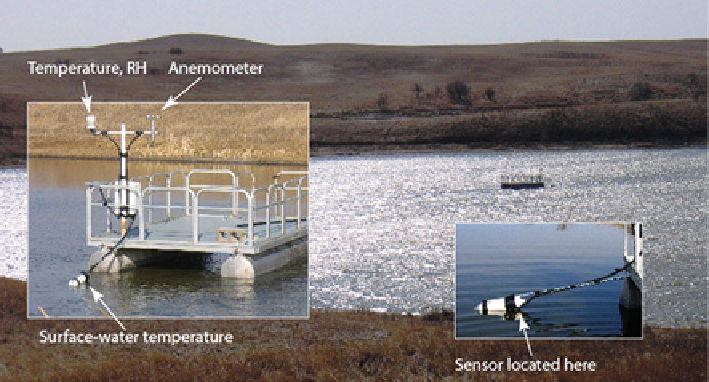Environmental Engineering Reference
In-Depth Information
Fig. 3.10 ET raft deployed on Cottonwood Lake Area Wetland P1.
Inset on left
shows raft being
put into place just after ice out. Surface-water-temperature sensor is located near the shallow end
of the float so it is resting just below the water surface. The white float minimizes heating from
solar loading (Photos by Donald Rosenberry)
water body. For settings where substantial horizontal variation in temperature
exists, such as in a wetland that has several embayments of differing total depth,
profiles of temperature sensors may need to be deployed at several locations to
accurately represent change in heat stored in the entire wetland. For other wetlands,
a single deployment of sensors at different depths may be sufficient. Rosenberry
et al. (
1993
) provide additional information regarding the errors associated with
making measurements at a single location relative to multiple locations. Tempera-
ture usually is measured with a thermistor, which has a non-linear, inverse electrical
resistance relative to temperature. Polynomial functions are applied to the resistor
output to provide temperature that commonly is within
0.1 to 0.5
C of true
temperature. Thermocouples are inexpensive and stable temperature-measurement
devices based on the principle that an electrical current is generated when a junction
is made between two dissimilar metals. The current is proportional to the tempera-
ture difference between two electrical junctions at different locations in the same
circuit. Output is linear and stable, but small. Temperature difference usually is
related to a separate temperature sensor located very near one of the bi-metal
junctions. If wires are well shielded with insulation so that temperature gradients
are small (or at least remain constant) in the vicinity of the reference thermometer,
modern dataloggers are well capable of resolving the small current changes that
occur in response to temperature changes.
Wind speed often increases approximately logarithmically with height above a
surface. Measurement of wind speed needs to be specified with regard to height
above the water surface. Measurement height is somewhat arbitrary, but 2 m is
common. Wind speed, air temperature, and humidity should all be measured at the
same height (Fig.
3.10
). All anemometers have a threshold below which the sensor

